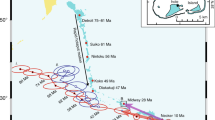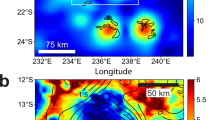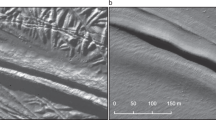Abstract
Enceladus is a small icy satellite of Saturn. Its south polar region consists of young, tectonically deformed terrain and has an anomalously high heat flux1,2. This heat flux is probably due to localized tidal dissipation within either the ice shell3 or the underlying silicate core4. The surface deformation is plausibly due to upwelling of low-density material (diapirism5) as a result of this tidal heating. Here we show that the current polar location of the hotspot can be explained by reorientation of the satellite's rotation axis because of the presence of a low-density diapir. If the diapir is in the ice shell, then the shell must be relatively thick and maintain significant rigidity (elastic thickness greater than ∼0.5 km); if the diapir is in the silicate core, then Enceladus cannot possess a global subsurface ocean, because the core must be coupled to the overlying ice for reorientation to occur. The reorientation generates large (∼10 MPa) tectonic stress patterns6 that are compatible with the observed deformation of the south polar region2. We predict that the distribution of impact craters on the surface will not show the usual leading hemisphere–trailing hemisphere asymmetry. A low-density diapir also yields a potentially observable negative gravity anomaly.
This is a preview of subscription content, access via your institution
Access options
Subscribe to this journal
Receive 51 print issues and online access
$199.00 per year
only $3.90 per issue
Buy this article
- Purchase on Springer Link
- Instant access to full article PDF
Prices may be subject to local taxes which are calculated during checkout


Similar content being viewed by others
References
Spencer, J. R. et al. Cassini encounters Enceladus: Background and the discovery of a south polar hot spot. Science 311, 1401–1405 (2006)
Porco, C. C. et al. Cassini observes the active south pole of Enceladus. Science 311, 1393–1401 (2006)
Ross, M. N. & Schubert, G. Viscoelastic models of tidal heating in Enceladus. Icarus 78, 90–101 (1989)
Matson, D. L. et al. Enceladus' interior and geysers–possibility for hydrothermal geochemistry. Lunar Planet Sci. Conf. XXXVII, abstr. 2219 (2006)
Pappalardo, R. T., Reynolds, S. J. & Greeley, R. Extensional tilt blocks on Miranda: Evidence for an upwelling origin of Arden Corona. J. Geophys. Res. 102, 13369–13379 (1997)
Melosh, H. J. Tectonic patterns on a reoriented planet: Mars. Icarus 44, 745–751 (1980)
Squyres, S. W., Reynolds, R. T. & Cassen, P. M. The evolution of Enceladus. Icarus 53, 319–331 (1983)
Wisdom, J. Spin-orbit secondary resonance dynamics of Enceladus. Astron. J. 128, 484–491 (2004)
Lissauer, J. J., Peale, S. J. & Cuzzi, J. N. Ring torque on Janus and the melting of Enceladus. Icarus 58, 159–168 (1984)
Gaidos, E. & Nimmo, F. Tectonics and water on Europa. Nature 405, 637 (2000)
Greenberg, R., et al. in Uranus (eds Bergstralh, J. T. et al.) 693–735 (Univ. Arizona Press, Tucson, 1991)
Janes, D. M. & Melosh, H. J. Sinker tectonics–an approach to the surface of Miranda. J. Geophys. Res. 93, 3127–3143 (1988)
Plescia, J. B. Cratering history of Miranda–implications for geologic processes. Icarus 73, 442–461 (1988)
Richards, M. A., Bunge, H. P., Ricard, Y. & Baumgardner, J. R. Polar wandering in mantle convection models. Geophys. Res. Lett. 26, 1777–1780 (1999)
Moser, J., Yuen, D. A., Larsen, T. B. & Matyska, C. Dynamical influences of depth-dependent properties on mantle upwellings and temporal variations of the moment of inertia. Phys. Earth Planet. Inter. 102, 153–170 (1997)
Ojakangas, G. W. & Stevenson, D. J. Polar wander of an ice shell on Europa. Icarus 81, 242–270 (1989)
Sotin, C., Head, J. W. & Tobie, G. Europa: tidal heating of upwelling thermal plumes and the origin of lenticulae and chaos melting. Geophys. Res. Lett. 29, 1233, doi:10.1029/2001GL013844 (2002)
Matsuyama, I., Mitrovica, J. X., Manga, M., Perron, J. T. & Richards, M. A. Rotational stability of dynamic planets with elastic lithospheres. J. Geophys. Res. 111, E02003, doi:10.1029/2005JE002447 (2006)
Willemann, R. J. Reorientation of planets with elastic lithospheres. Icarus 60, 701–709 (1984)
Tsai, V. C. & Stevenson, D. J. Theoretical constraints on true polar wander. Eos 86, GP21A–02 (2005)
Moore, W. B. & Schubert, G. The tidal response of Europa. Icarus 147, 317–319 (2000)
Turcotte, D. L., Willemann, R. J., Haxby, W. F. & Norberry, J. Role of membrane stresses in the support of planetary topography. J. Geophys. Res. 86, 3951–3959 (1981)
Nimmo, F., Pappalardo, R. T. & Giese, B. Elastic thickness and heat flux estimates on Ganymede. Geophys. Res. Lett. 29, doi:10.1029/2001GL013976 (2002)
Nimmo, F., Pappalardo, R. T. & Giese, B. On the origins of band topography Europa. Icarus 166, 21–32 (2003)
Palguta, J., Anderson, J. D., Schubert, G. & Moore, W. B. Mass anomalies on Ganymede. Icarus 180, 428–441 (2006)
Ojakangas, G. W. & Stevenson, D. J. Episodic volcanism of tidally-heated satellites with application to Io. Icarus 66, 341–358 (1986)
McNamara, A. K. & Zhong, S. J. Degree-one mantle convection: Dependence on internal heating and temperature-dependent rheology. Geophys. Res. Lett. 32, L01301, doi:10.1029/2004GL021082 (2005)
Turcotte, D. L. & Schubert, G. Geodynamics 2nd edn (Cambridge Univ. Press, Cambridge, UK, 2002)
Morrison, D., Owen, T. & Soderblom, L. A. in Satellites (eds Burns, J. A. & Matthews, M. S.) 764–801 (Univ. Arizona Press, Tucson, 1986)
McKinnon, W. B. in Solar System Ices (eds Schmitt, B., de Bergh, C. & Festou, M.) 525–550 (Kluwer Academic, Dordrecht, 1998)
Acknowledgements
We thank J. Moore, J. Melosh and M. Mullen for comments. This research was supported by NASA PGG and OPR.
Author information
Authors and Affiliations
Corresponding author
Ethics declarations
Competing interests
Reprints and permissions information is available at npg.nature.com/reprintsandpermissions. The authors declare no competing financial interests.
Supplementary information
Supplementary Methods
This file gives the derivation of the degree-two gravitational potential G20 and gives further details on the calculation of the resulting gravity anomaly, the k2 Love numbers of the satellite and the derivation of equation (1) for a tidally-distorted body. (DOC 39 kb)
Rights and permissions
About this article
Cite this article
Nimmo, F., Pappalardo, R. Diapir-induced reorientation of Saturn's moon Enceladus. Nature 441, 614–616 (2006). https://doi.org/10.1038/nature04821
Received:
Accepted:
Issue Date:
DOI: https://doi.org/10.1038/nature04821
This article is cited by
-
Evidence for lunar tide effects in Earth’s plasmasphere
Nature Physics (2023)
-
Origin and Evolution of Enceladus’s Tidal Dissipation
Space Science Reviews (2023)
-
True polar wander in the Earth system
Science China Earth Sciences (2023)
-
Enceladus as a potential oasis for life: Science goals and investigations for future explorations
Experimental Astronomy (2022)
-
Cascading parallel fractures on Enceladus
Nature Astronomy (2019)
Comments
By submitting a comment you agree to abide by our Terms and Community Guidelines. If you find something abusive or that does not comply with our terms or guidelines please flag it as inappropriate.



